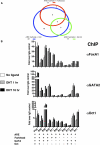A hierarchical network of transcription factors governs androgen receptor-dependent prostate cancer growth
- PMID: 17679089
- PMCID: PMC3947890
- DOI: 10.1016/j.molcel.2007.05.041
A hierarchical network of transcription factors governs androgen receptor-dependent prostate cancer growth
Abstract
Androgen receptor (AR) is a ligand-dependent transcription factor that plays a key role in prostate cancer. Little is known about the nature of AR cis-regulatory sites in the human genome. We have mapped the AR binding regions on two chromosomes in human prostate cancer cells by combining chromatin immunoprecipitation (ChIP) with tiled oligonucleotide microarrays. We find that the majority of AR binding regions contain noncanonical AR-responsive elements (AREs). Importantly, we identify a noncanonical ARE as a cis-regulatory target of AR action in TMPRSS2, a gene fused to ETS transcription factors in the majority of prostate cancers. In addition, through the presence of enriched DNA-binding motifs, we find other transcription factors including GATA2 and Oct1 that cooperate in mediating the androgen response. These collaborating factors, together with AR, form a regulatory hierarchy that governs androgen-dependent gene expression and prostate cancer growth and offer potential new opportunities for therapeutic intervention.
Figures







References
-
- Balk SP, Ko YJ, Bubley GJ. Biology of prostate-specific antigen. J. Clin. Oncol. 2003;21:383–391. - PubMed
-
- Boyes J, Byfield P, Nakatani Y, Ogryzko V. Regulation of activity of the transcription factor GATA-1 by acetylation. Nature. 1998;396:594–598. - PubMed
-
- Carroll JS, Liu XS, Brodsky AS, Li W, Meyer CA, Szary AJ, Eeckhoute J, Shao W, Hestermann EV, Geistlinger TR, et al. Chromosome-wide mapping of estrogen receptor binding reveals long-range regulation requiring the forkhead protein FoxA1. Cell. 2005;122:33–43. - PubMed
-
- Carroll JS, Meyer CA, Song J, Li W, Geistlinger TR, Eeckhoute J, Brodsky AS, Keeton EK, Fertuck KC, Hall GF, et al. Genome-wide analysis of estrogen receptor binding sites. Nat. Genet. 2006;38:1289–1297. - PubMed
-
- Cirillo LA, Lin FR, Cuesta I, Friedman D, Jarnik M, Zaret KS. Opening of compacted chromatin by early developmental transcription factors HNF3 (FoxA) and GATA-4. Mol. Cell. 2002;9:279–289. - PubMed
Publication types
MeSH terms
Substances
Associated data
- Actions
Grants and funding
LinkOut - more resources
Full Text Sources
Other Literature Sources
Medical
Molecular Biology Databases
Research Materials

